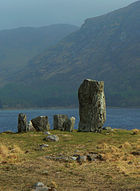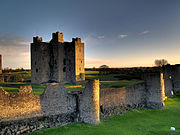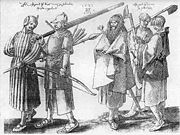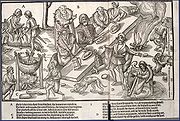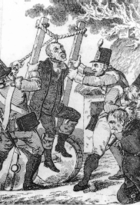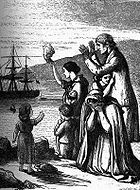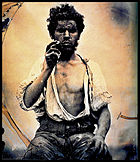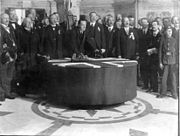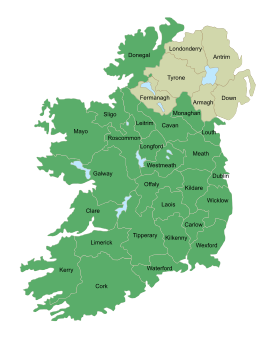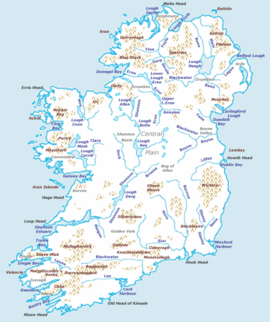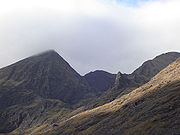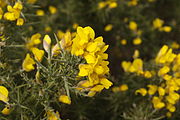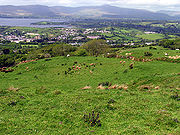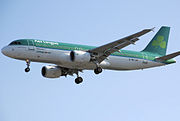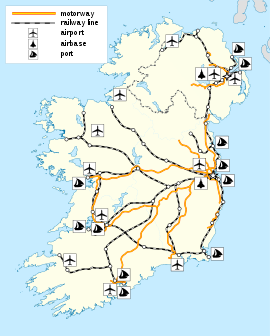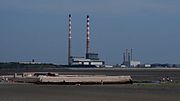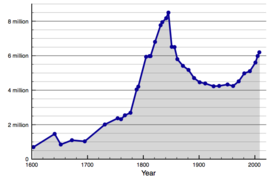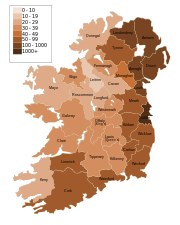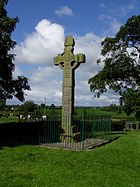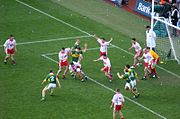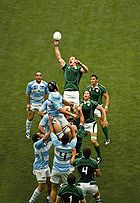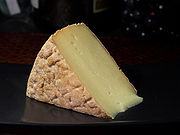
Ireland
About this schools Wikipedia selection
This content from Wikipedia has been selected by SOS Children for suitability in schools around the world. Click here for more information on SOS Children.
Coordinates: 53°N 07°W
| Native name: Éire / Ireland Nickname: The Emerald Isle / The Island of Saints and Scholars |
|
|---|---|
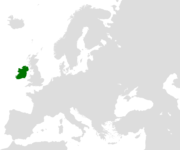 |
|
| Geography | |
| Location | Northern Europe or Western Europe |
| Area | 84,421 km2 (32,595.1 sq mi) |
| Area rank | 20th |
| Coastline | 1,000 km (600 mi) |
| Highest elevation | 1,041 m (3,415 ft) |
| Highest point | Carrauntoohil |
| Country | |
| Largest city | Dublin |
| Region | Northern Ireland |
| Largest city | Belfast |
| Demographics | |
| Population | 6,197,100 (as of 2008) |
| Density | 73.4 /km2 (190.1 /sq mi) |
| Ethnic groups | Irish, Ulster Scots, Irish Travellers |
Ireland (pronounced [ˈaɪɾlənd]; Irish: Éire [ˈeːɾʲə]; Ulster Scots: Airlann) is the third-largest island in Europe and the twentieth-largest island in the world. It lies to the northwest of continental Europe and is surrounded by hundreds of islands and islets. To the east of Ireland is Great Britain, separated from it by the Irish Sea. The island is divided between the Republic of Ireland, which covers just under five-sixths of the island, and Northern Ireland, a part of the United Kingdom, which covers the remainder and is located in the northeast of the island. The population of Ireland is approximately 6.2 million people. Just under 4.5 million live in the Republic of Ireland and just under 1.8 million live in Northern Ireland.
Relatively low-lying mountains surrounding a central plain epitomise Ireland's geography with several navigable rivers extending inland. The island has lush vegetation, a product of its mild but changeable oceanic climate, which avoids extremes in temperature. Thick woodlands covered the island until the 17th century. Today, it is the most deforested area in Europe. There are twenty-six extant mammal species native to Ireland.
A Norman invasion in the Middle Ages gave way to a Gaelic Resurgence in the 13th century. Over sixty years of intermittent warfare in the 1500s led to English dominion after 1603. In the 1690s, a system of Protestant English rule was designed to materially disadvantage the Catholic majority and Protestant dissenters, and was extended during the 18th century. In 1801, Ireland became a part of the United Kingdom. A war of independence in the early 20th century led to the partition of the island, creating the Irish Free State, which became increasingly sovereign over the following decades. Northern Ireland remained a part of the United Kingdom and saw much civil unrest from the late 1960s until the 1990s. This subsided following a political agreement in 1998. In 1973, both parts of Ireland joined the European Community.
Irish culture has had a significant influence on other cultures, particularly in the fields of literature and, to a lesser degree, science and education. A strong Irish culture exists, as expressed for example through Gaelic games, Irish music and the Irish language, alongside a common Western culture, such as contemporary music and drama, and sports such as soccer, rugby and golf, and the English language.
History
Pre-history and medieval period
Most of Ireland was covered with ice until the end of the last ice age over 9,000 years ago. Sea-levels were lower and Ireland, like Great Britain, was part of continental Europe. Mesolithic stone age inhabitants arrived some time after 8,000 BC and agriculture followed with the Neolithic Age around 4,500 to 4,000 BC when sheep, goats, cattle and cereals were imported from the Iberian peninsula.
At the Céide Fields, preserved beneath a blanket of peat in present-day County Mayo, is an extensive field system, arguably the oldest in the world, dating from not long after this period. Consisting of small divisions separated by dry-stone walls, the fields were farmed for several centuries between 3,500 and 3,000 BC. Wheat and barley were the principal crops.
The Bronze Age – defined by the use of metal – began around 2,500 BC, with technology changing people's everyday lives during this period through innovations such as the wheel, harnessing oxen, weaving textiles, brewing alcohol, and skillful metalworking, which produced new weapons and tools, along with fine gold decoration and jewellery, such as brooches and torcs. According to John T. Koch and others, Ireland in the Late Bronze Age was part of a maritime trading-networked culture called the Atlantic Bronze Age that also included Britain, France, Spain and Portugal where Celtic languages developed.
The Iron Age in Ireland is traditionally associated with people known as the Celts. The Celts were commonly thought to have colonised Ireland in a series of invasions between the 8th and 1st centuries BC. The Gaels, the last wave of Celts, were said to have divided the island into five or more kingdoms after conquering it. However, some academics favour a theory that emphasises the diffusion of culture from overseas as opposed to a military colonisation. Finds such as Clonycavan Man are given as evidence for this theory.
The earliest written records of Ireland come from classical Greco-Roman geographers. Ptolemy in his Almagest refers to Ireland as Mikra Brettania (Lesser Britain), in contrast to the larger island, which he called Megale Brettania (Great Britain). In his later work, Geography, Ptolemy refers to Ireland as Iwernia and to Great Britain as Albion. These "new" names were likely to have been the Celtic names for the islands at the time. The earlier names, in contrast, were likely to have been coined before direct contact with local peoples were made.
The Romans would later refer to Ireland by this name too in its Latinised form, Hibernia, or Scotia. Ptolemy records sixteen tribes inhabiting every part of Ireland in 100 AD. The relationship between the Roman Empire and the tribes of ancient Ireland is unclear. However, a number of finds of Roman coins have been found, for example at New Grange.
Ireland continued as a patchwork of rival tribes but, beginning in the 7th century AD, a concept of national kingship gradually became articulated through the concept of a High King of Ireland. Medieval Irish literature portrays an almost unbroken sequence of High Kings stretching back thousands of years but modern historians believe the scheme was constructed in the 8th century to justify the status of powerful political groupings by projecting the origins of their rule into the remote past.
The High King was said to preside over the patchwork of provincial kingdoms that together formed Ireland. Each of these kingdoms had their own kings but were at least nominally subject to the High King. The High King was drawn from the ranks of the provincial kings and ruled also the royal kingdom of Meath, with a ceremonial capital at the Hill of Tara. The concept only became a political reality in the Viking Age and even then was not a consistent one. However, Ireland did have a unifying rule of law: the early written judicial system, the Brehon Laws, administered by a professional class of jurists known as the brehons.
The Chronicle of Ireland records that in 431 AD Bishop Palladius arrived in Ireland on a mission from Pope Celestine I to minister to the Irish "already believing in Christ." The same chronicle records that Saint Patrick, Ireland's best known patron saint, arrived the following year. There is continued debate over the missions of Palladius and Patrick but consensus that they both took place and certainty that the older druid tradition collapsed in the face of the new religion. Irish Christian scholars excelled in the study of Latin and Greek learning and Christian theology. In the monastic culture that followed the Christianisation of Ireland, Latin and Greek learning was preserved in Ireland during the Early Middle Ages in contrast to elsewhere in Europe, where the Dark Ages followed the decline of the Roman Empire.
The arts of manuscript illumination, metalworking and sculpture flourished and produced treasures such as the Book of Kells, ornate jewellery and the many carved stone crosses that still dot the island today. A mission founded in 563 on Iona by the Irish monk Saint Columba began a tradition of Irish missionary work that spread Christianity and learning to Scotland, England and the Frankish Empire on Continental Europe after the fall of Rome. These missions continued until the late middle ages, establishing monasteries and centres of learning, producing scholars such as Sedulius Scottus and Johannes Eriugena and exerting much influence in Europe.
From the 9th century, waves of Viking raiders plundered Irish monasteries and towns. These raids added to a pattern of raiding and endemic warfare that was already deep-seated in Ireland.
Norman and English invasions
On May 1, 1169, an expedition of Cambro- Norman knights with an army of about six hundred landed at Bannow Strand in present-day County Wexford. It was led by Richard de Clare, called Strongbow due to his prowess as an archer. The invasion, which coincided with a period of renewed Norman expansion, was at the invitation of Dermot Mac Murrough, king of Leinster.
In 1166, Mac Morrough had fled to Anjou, France following a war involving Tighearnán Ua Ruairc, of Breifne, and sought the assistance of the Angevin king, Henry II, in recapturing his kingdom. In 1171, Henry arrived in Ireland in order to review the general progress of the expedition. He wanted to re-exert royal authority over the invasion which was expanding beyond his control. Henry successfully re-imposed his authority over Strongbow and the Cambro-Norman warlords and persuaded many of the Irish kings to accept him as their overlord, an arrangement confirmed in the 1175 Treaty of Windsor.
The invasion was legitimised by the provisions of the Papal Bull Laudabiliter, issued by Adrian IV in 1155. The bull encouraged Henry to take control in Ireland in order to oversee the financial and administrative reorganisation of the Irish Church and its integration into the Roman Church system. Some restructuring had already begun at the ecclesiastical level since the Synod of Kells in 1152. There has been some controversy over the bull, but its authenticity is now generally accepted. It granted Henry dominion over Ireland in the name of the papacy.
In 1172, the new pope, Alexander III, further encouraged Henry to advance the integration of the Irish Church with Rome. Henry was authorised to impose a tithe of one penny per hearth as an annual contribution. This church levy, called Peter's Pence, is still extant in Ireland as a voluntary donation. In turn, Henry accepted the title of Lord of Ireland which Henry conferred on his younger son, John Lackland, in 1185. This defined the Irish state as the Lordship of Ireland. When Henry's successor died unexpectedly in 1199, John inherited the crown of England and retained the Lordship of Ireland.
Over the century that followed, Norman feudal law gradually replaced the Gaelic Brehon Law so that by the late 13th century the Norman-Irish had established a feudal system throughout much of Ireland. Norman settlements were characterised by the establishment of baronies, manors, towns and the seeds of the modern county system. A version of the Magna Carta (the Great Charter of Ireland), substituting Dublin for London and Irish Church for Church of England, was published in 1216 and the Parliament of Ireland was founded in 1297.
However, from the mid-14th century, after the Black Death, Norman settlements in Ireland went into a period of decline. The Norman rulers and the Gaelic Irish elites intermarried and the areas under Norman rule became Gaelicised. In some parts, a hybrid Hiberno-Norman culture emerged. In response, the Irish parliament passed the Statutes of Kilkenny in 1367. These were a set of laws designed to prevent the assimilation of the Normans into Irish society by requiring English subjects in Ireland to speak English, follow English customs and abide by English law. However, by the end of the 15th century central English authority in Ireland had all but disappeared and a renewed Irish culture and language, albeit with Norman influences, was dominant again. English Crown control remained relatively unshaken in an amorphous foothold around Dublin known as The Pale and under the provisions of Poynings' Law of 1494, the Irish Parliamentary legislation was subject to the approval of the English Parliament.
English rule of law was reinforced and expanded, in the 16th century leading to the Tudor conquest of Ireland. A near complete conquest was achieved by the turn of the 17th century following the Nine Years' War and the Flight of the Earls. This control was further consolidated during the wars and conflicts of the 17th century, which witnessed English and Scottish colonisation in the Plantations of Ireland, the Wars of the Three Kingdoms and the Williamite War. Irish losses during the Wars of the three Kingdoms (which, in Ireland, included the Irish Confederacy and the Cromwellian conquest of Ireland) are estimated to include 20,000 battlefield casualties. 200,000 civilians are estimated to have died as a result of a combination of war-related famine, displacement, guerilla activity and pestilence over the duration of the war. A further 50,000 were sent to slavery in the West Indies. Some historians estimate that as much as half of the pre-war population of Ireland may have died as a result of the conflict.
The religious struggles of the 17th century left a deep sectarian division in Ireland. Religious allegiance now determined the perception in law of loyalty to the Irish King and Parliament. After the passing of the Test Act 1672, and with the victory of the forces of the dual monarchy of William and Mary over the Jacobites, Roman Catholics and nonconforming Protestant Dissenters were barred from sitting as members in the Irish Parliament. Under the emerging penal laws, recusant Irish Roman Catholics and Dissenters were increasingly deprived of various and sundry civil rights even to the ownership of hereditary property. Additional regressive punitive legislation followed 1703, 1709 and 1728. This completed a comprehensive systemic effort to materially disadvantage Roman Catholics and Protestant Dissenters, while enriching a new ruling class of Anglican conformists. The new Anglo-Irish ruling class became known as the Protestant Ascendancy.
Union with Great Britain
An extraordinary climatic shock known as " The Great Frost" struck Ireland and the rest of Europe between December 1739 and September 1741, after a decade of relatively mild winters. The winters destroyed stored crops of potatoes and other staples and the poor summers severely damaged harvests. This resulted in the famine in 1740. An estimated 250,000 people (about one in eight of the population) died from the ensuing pestilence and disease. The Irish government halted export of corn and kept the army in quarters but did little more. Local gentry and charitable organisations provided relief but could not contain the ensuing mortality.
In the aftermath of the famine, an increase in industrial production and a surge in trade brought a succession of construction booms. The population soared in the latter part of this century and the architectural legacy of Georgian Ireland was built. In 1782, Poynings' Law was repealed giving Ireland virtual legislative independence from Great Britain for the first time since the Norman invasion. However, the British government still retained the right to nominate the government of Ireland above the consent of the Irish parliament.
In 1798, members of the Protestant Dissenter tradition (mainly Presbyterian) made common cause with Catholics in a republican rebellion inspired and led by the Society of United Irishmen with the aim of creating an independent Ireland. Despite assistance from France the rebellion was put down by British and Irish government and yeomanry forces. In 1800, the British and Irish parliaments passed the Act of Union which, effective as of January 1, 1801, merged the Kingdom of Ireland and the Kingdom of Great Britain to create a United Kingdom of Great Britain and Ireland.
The passage of the Act in the Irish Parliament was ultimately achieved with substantial majorities, having failed on the first attempt in 1799. According to contemporary documents and historical analysis, this was achieved through a considerable degree of bribery, with funding provided by the British Secret Service Office, and the awarding of peerages, places and honours to secure votes. Thus, Ireland became part of an extended United Kingdom, ruled directly by the parliament at Westminster in London. A Viceregal administration was established and under the government appointed the Chief Secretary at Dublin Castle.
The Great Famine of the 1840s caused the deaths of one million Irish people and over a million more emigrated to escape it. By the end of the decade, half of all immigration to the United States was from Ireland. Mass emigration became deeply entrenched and the population continued to decline until the mid 20th century. Immediately prior to the famine, the population was recorded as 8.2 million by the 1841 census. The population has never returned to this level since. The population continued to fall until 1961 and it was not until the 2006 census that the last county of Ireland ( County Leitrim) to record a rise in population since 1841 did so.
The 19th and early 20th century saw the rise of modern Irish nationalism, primarily among the Roman Catholic population. Pre-eminent among these was Daniel O'Connell. He was elected as member of parliament for Ennis in a surprise result despite being unable to take his seat as a Roman Catholic. O'Connell spearheaded a vigorous campaign which was taken up by the Prime Minister, the Irish-born soldier and statesman, the Duke of Wellington. Steering the Act through the Westminster parliament, aided by future prime minister Robert Peel, Wellington prevailed upon a reluctant George IV to sign the bill and proclaim it into law. George's father had opposed the plan of the earlier Prime Minister, Pitt the Younger, to introduce such a bill following the Union in 1801 fearing Catholic Emancipation to be in conflict with the Act of Settlement 1701.
A subsequent campaign led by O'Connell for the repeal of the Act of Union failed. Later in the century, Charles Stewart Parnell and others campaigned for autonomy within the Union, or " Home Rule". Unionists, especially those located in the northern part of the island, were strongly opposed to Home Rule, which they thought would be dominated by Catholic interests. After several attempts to pass a Home Rule bill through parliament, it looked certain that one would finally pass in 1914. To prevent this from happening, the Ulster Volunteers were formed in 1913 under the leadership of Lord Carson.
Their formation was followed in 1914 by the establishment of the Irish Volunteers, whose aim was to ensure that the Home Rule Bill was passed. The Act was passed but with the "temporary" exclusion of the six counties of Ulster that would become Northern Ireland. However, before it could be implemented the Act was suspended for the duration of the Great War (World War I). The Irish Volunteers split into two groups. The majority, approximately 175,000 in number, under John Redmond, took the name National Volunteers and supported Irish involvement in the war. A minority, approximately 13,000, retained the name, the Irish Volunteers, and opposed Ireland's involvement in the war.
The failed Easter Rising of 1916 was carried out by the latter group in alliance with a smaller socialist militia, the Irish Citizen Army. The British response, executing the leaders of the Rising one by one over seven weeks, changed the national mood towards Home Rule. The pro-independence party, Sinn Féin, received overwhelming endorsement in the General Election of 1918 and in 1919 declared its own parliament and government, the Irish Republic. British authorities attempted to extinguish this challenge, sparking a guerilla war from 1919 to July 1921, ending in a truce.
In 1921, the Anglo-Irish Treaty was concluded between the British Government and representatives of the First Dáil (Assembly of Ireland). It gave all of Ireland complete independence in their home affairs and practical independence for foreign policy. However, an oath of allegiance to the British Crown had to be exercised. And Northern Ireland was to form a home rule state within the new Irish Free State but held an opt-out clause, which it exercised immediately as expected. Disagreements over these provisions led to a split in the nationalist movement and a subsequent civil war between the new government of the Irish Free State and those opposed to the treaty, led by Éamon de Valera. The civil war officially ended in May 1923 when de Valera issued a cease-fire order.
Partition
Independent Ireland
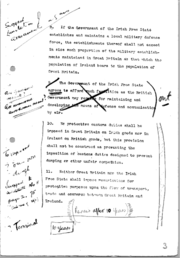
During its first decade, the newly formed Irish Free State was governed by the victors of the civil war. When de Valera achieved power, he took advantage of the Statute of Westminster and political circumstances to build upon inroads to greater sovereignty made by the previous government. The oath was abolished and in 1937 a new constitution was adopted. This completed a process of gradual separation from the British Empire that governments had pursued since independence. However, it was not until 1949 that the state was declared, officially, to be the Republic of Ireland.
The state was neutral during World War II, but offered clandestine assistance to the Allies, particularly in the potential defence of Northern Ireland. Despite being neutral, approximately 50,000 volunteers from independent Ireland joined the British forces during the war, four being awarded Victoria Crosses.
Ireland was also targeted by German Intelligence. Both the Abwehr (the German military intelligence service) and the SD (the Sicherheitsdienst, the intelligence service of the SS) sent agents to Ireland. This intelligence-gathering effort was disrupted in September 1941 when the southern Irish police made arrests on the basis of surveillance carried out on the key diplomatic legations in Ireland, including the United States. To the southern Irish, counterintelligence was more than mere luxury but a fundamental line of defense. With a regular army of only slightly over seven thousand men at the start of the war, and hopelessly devoid of modern weapons, a determined German attack with even just a few divisions would have meant certain occupation.
Large-scale emigration marked the 1950s and 1980s but, beginning in 1987, the economy improved and the 1990s saw the beginning of substantial economic growth. This period of growth became known as the Celtic Tiger. The Republic's real GDP grew by an average of 9.6% per annum between 1995 and 1999 and in 2000 Ireland was the sixth-richest country in the world in terms of GDP per capita. Social changes followed quickly on the heels of economic prosperity ranging from the 'modernisation' of the St. Patrick's Day parade in Dublin to the decline in authority of the Catholic Church. The financial crisis of 2008–2010 dramatically ended this period of boom. GDP fell by 3% in 2008 and by 7.1% in 2009, the worst year since records began (although earnings by foreign-owned businesses continued to grow).
Northern Ireland
Northern Ireland was created as a division of the United Kingdom by the Government of Ireland Act 1920 and until 1972 it was a self-governing jurisdiction within the United Kingdom with its own parliament and prime minister. Northern Ireland, as part of the United Kingdom, was not neutral during the Second World War and Belfast suffered four bombing raids in 1941. Conscription was not extended to Northern Ireland and roughly an equal number volunteered from Northern Ireland as volunteered from the south. One, James Joseph Magennis, received the Victoria Cross for valour.
Although Northern Ireland was largely spared the strife of the civil war, in decades that followed partition there were sporadic episodes of inter-communal violence. Nationalists, mainly Roman Catholic, wanted to unite Ireland as an independent republic, whereas unionists, mainly Protestant, wanted Northern Ireland to remain in the United Kingdom. The Protestant and Catholic communities in Northern Ireland voted largely along sectarian lines, meaning that the Government of Northern Ireland (elected by "first past the post" from 1929) was controlled by the Ulster Unionist Party. Over time, the minority Catholic community felt increasingly alienated with further disaffection fueled by practices such as gerrymandering and discrimination in housing and employment.
In the late 1960s, nationalist grievances were aired publicly in mass civil rights protests, which were often confronted by loyalist counter-protests. The government's reaction to confrontations was seen to be one-sided and heavy-handed in favour of unionists. Law and order broke down as unrest and inter-communal violence increased. The Northern Ireland government requested the British Army to aid the police, who were exhausted after several nights of serious rioting. In 1969, the paramilitary Provisional IRA, which favoured the creation of a united Ireland, emerged from a split in the Irish Republican Army and began a campaign against what it called the "British occupation of the six counties".
Other groups, on both the unionist side and the nationalist side, participated in violence and a period known as the Troubles began. Over 3,600 deaths resulted over the subsequent three decades of conflict. Owing to the civil unrest during the Troubles, the British government suspended home rule in 1972 and imposed " direct rule" from the Parliament of the United Kingdom. There were several ultimately unsuccessful attempts to end the Troubles politically, such as the Sunningdale Agreement of 1973. In 1998, following a ceasefire by the Provisional IRA and multi-party talks, the Belfast Agreement was concluded as a treaty between the United Kingdom and the Republic of Ireland, annexing the text agreed in the multi-party talks; the substance of the Agreement (often referred to as the Good Friday Agreement) was later endorsed by referendums in both parts of the island of Ireland. The Agreement restored self-government to Northern Ireland on the basis of power-sharing among the major parties, with entrenched protections for the two main communities. Violence decreased greatly after the signing of the accord and in 2005 the Provisional IRA announced the end of its armed campaign and an independent commission supervised its disarmament and that of other nationalist and unionist paramilitary organisations. The power-sharing assembly was suspended several times but was restored again in 2007. In that year, the British government officially ended its military support of the police in Northern Ireland and began withdrawing troops.
Governance
Ireland is occupied by two political entities:
- The Republic of Ireland, ratified 21 January 1919 and officially formed on the 6 December 1922, ( officially Ireland), a sovereign state that covers five-sixths of the island. Its capital is Dublin.
- Northern Ireland, established on the 3 May 1921, is a part of the United Kingdom that covers the remaining sixth. Its capital is Belfast.
Traditionally, Ireland is subdivided into four provinces: Connacht (west), Leinster (east), Munster (south), and Ulster (north). In a system that developed between the 13th and 17th centuries, Ireland has thirty-two traditional counties. Twenty-six of the counties are in the Republic of Ireland and six counties are in Northern Ireland. The six counties that constitute Northern Ireland are all in the province of Ulster (which has nine counties in total). As such, Ulster is often used as a synonym for Northern Ireland, although the two are not coterminous.
In the Republic of Ireland, counties form the basis of the system of local government. Counties Dublin, Cork, Limerick, Galway, Waterford and Tipperary have been broken up into smaller administrative areas. However, they are still treated as counties for cultural and some official purposes, for example post and by the Ordnance Survey Ireland. Counties in Northern Ireland are no longer used for local governmental purposes, but, as in the Republic, their traditional boundaries are still used for informal purposes such as sports leagues and in cultural or tourism contexts.
City status in Ireland is decided by legislative or royal charter. Dublin, with just over 1 million residents in the Greater Dublin Area, is the largest city on the island. Other cities are:
- Belfast (urban area: 267,742, metropolitan area: 575,231)
- Cork (urban area: 190,384)
- Derry (urban area: 93,512)
- Limerick (urban area: 90,757)
- Galway (urban area: 72,729)
- Lisburn (urban area: 71,465)
- Waterford (urban area: 49,213)
- Newry (urban area: 29,946)
- Armagh (urban area: 15,020)
Kilkenny (pop. 22,179), while strictly no longer a city, is entitled by law to describe itself as such. Several towns have larger populations than some of these cities, such as Drogheda (pop. 35,090) and Dundalk (pop. 35,085) but are not recognised as cities because they lack historic charters or legal status.
| Province | Population | Area (km²) | Density (p/km²) | Largest city |
|---|---|---|---|---|
| Connacht | 503,083 | 17,713 | 28 | Galway |
| Leinster | 2,292,939 | 19,801 | 100 | Dublin |
| Munster | 1,172,170 | 24,608 | 48 | Cork |
| Ulster | 2,008,333 | 22,300 | 90 | Belfast |
All-island institutions
Despite the political partition, the island of Ireland continues to act as a single entity in a number of areas that transcend governmental agencies. The two jurisdictions share transport, telecommunications, energy and water systems. With a few notable exceptions, the island is the main organisational unit for major religious, cultural and sporting organisations. The island fields a single international team in most sports, for example, and March 17 is celebrated throughout Ireland as the traditional Irish holiday of St. Patrick's Day. One notable exception to this is Association football, although both associations continued to field international teams under the name "Ireland" until the 1950s. An all-Ireland club competition for soccer, the Setanta Cup, was created in 2005.
The 1998 Belfast Agreement provides for political co-operation between the two jurisdictions. The North-South Ministerial Council, established under the agreement, is an institution through which ministers from the Government of Ireland and the Northern Ireland Executive can formulate all-island policies in twelve "areas of co-operation" such as agriculture, the environment and transport. Six of these policy areas have associated all-island "implementation bodies". For example, food safety is managed by the Food Safety Promotion Board and Tourism Ireland markets the island as a whole. Three major political parties, Sinn Féin, the Irish Green Party and, most recently, Fianna Fáil, are organised on an all-island basis. However, only the former two of these have contested elections and hold legislative seats in both jurisdictions.
Despite the two jurisdictions using two distinct currencies (the euro and pound sterling), a growing amount of commercial activity is carried out on an all-island basis. This has in part been facilitated by the two jurisdictions' shared membership of the European Union. Calls for the creation of an "all-island economy" have been made from members of the business community and policymakers so as to benefit from economies of scale and boost competitiveness. One area in which the island already operates largely as a single market is electricity and there are plans for the creation of an all-island gas market. Support for such initiatives comes from the Irish government and nationalist parties in the Northern Ireland Assembly.
Geography
The island of Ireland is located in the north-west of Europe. It is separated from the neighbouring island of Great Britain by the Irish Sea and the North Channel, which has a width of 23 kilometres (14 mi) at its narrowest point. To the west is the northern Atlantic Ocean and to the south is the Celtic Sea, which spans south-eastwardly from Ireland to Brittany, in France. Ireland and Great Britain, together with nearby islands, are known collectively as the British Isles. As the term British Isles is controversial in relation to Ireland, the alternate term Ireland and Britain is often used as a neutral term for the islands.
A ring of coastal mountains surround low plains at the centre of the island. The highest of these is Carrauntoohil ( Irish: Corrán Tuathail) in County Kerry, which rises to 1,038 m (3,406 ft) above sea level. The most arable land lies in the province of Leinster. Western areas can be mountainous and rocky with green panoramic vistas. The River Shannon, the island's longest river at 386 km (240 mi) long, rises in County Cavan in the north west and flows 113 kilometres (70 mi) to Limerick city in the mid west.
The island's lush vegetation, a product of its mild climate and frequent rainfall, earns it the sobriquet the Emerald Isle. Overall, Ireland has a mild but changeable oceanic climate with few extremes. The climate is typically insular and is temperate avoiding the extremes in temperature of many other areas in the world at similar latitudes. This is a result of the moderating moist winds which ordinarily prevail from the South-Western Atlantic.
Precipitation falls throughout the year but is light overall, particularly in the east. The west tends to be wetter on average and prone to Atlantic storms, especially in the late autumn and winter months. These occasionally bring destructive winds and higher total rainfall to these areas, as well as sometimes snow and hail. The regions of north County Galway and east County Mayo have the highest incidents of recorded lightning annually for the island, with lightening occurring approximately five to ten days per year in these areas. Munster, in the south, records the least snow whereas Ulster, in the north, records the most.
Inland areas are warmer in summer and colder in winter. Usually around 40 days of the year are below freezing 0 °C (32 °F) at inland weather stations, compared to 10 days at coastal stations. Ireland is sometimes affected by heat waves, most recently in 1995, 2003 and 2006. In common with the rest of Europe, Ireland experienced unusually cold weather during the winter of 2009/10. Temperatures fell as low as −13 °C (9 °F) in some parts and up to a metre (3 ft) of snow in mountainous areas.
The island consists of varied geological provinces. In the far west, around County Galway and County Donegal, is a medium to high grade metamorphic and igneous complex of Caledonide affinity, similar to the Scottish Highlands. Across southeast Ulster and extending southwest to Longford and south to Navan is a province of Ordovician and Silurian rocks, with similarities to the Southern Uplands province of Scotland. Further south, along the County Wexford coastline, is an area of granite intrusives into more Ordovician and Silurian rocks, like that found in Wales. In the southwest, around Bantry Bay and the mountains of Macgillicuddy's Reeks, is an area of substantially deformed, but only lightly metamorphosed, Devonian-aged rocks. This partial ring of "hard rock" geology is covered by a blanket of Carboniferous limestone over the centre of the country, giving rise to a comparatively fertile and lush landscape. The west-coast district of the Burren around Lisdoonvarna has well developed karst features. Significant stratiform lead-zinc mineralization is found in the limestones around Silvermines and Tynagh.
Hydrocarbon exploration is ongoing following the first major find at the Kinsale Head gas field off Cork in the mid-1970s. More recently, in 1999, economically significant finds of natural gas were made in the Corrib Gas Field off the County Mayo coast. This has increased activity off the west coast in parallel with the "West of Shetland" step-out development from the North Sea hydrocarbon province. The Helvick oil field, estimated to contain over 28 million barrels (4,500,000 m3) of oil, is another recent discovery.
Places of interest
There are three World Heritage Sites on the island: the Brú na Boinne, Skellig Michael and the Giant's Causeway. A number of other places are on the tentative list, for example the Burren and Mount Stewart.
Some of the most visited sites in Ireland include Bunratty Castle, the Rock of Cashel, the Cliffs of Moher, Holy Cross Abbey and Blarney Castle. Historically important monastic sites include Glendalough and Clonmacnoise, which are maintained as national monuments in the Republic of Ireland.
Dublin is the most heavily touristed region and home to several of the most popular attractions such as the Guinness Storehouse and Book of Kells. The west and south west, which includes the Lakes of Killarney and the Dingle peninsula in County Kerry and Connemara and the Aran Islands in County Galway, are also popular tourist destinations. Achill Island lies off the coast of County Mayo and is Ireland's largest island. It is a popular tourist destination for surfing and contains 5 Blue Flag beaches and Croaghaun one of the worlds highest sea cliffs. Stately homes, built during the 17th, 18th and 19th centuries in Palladian, Neoclassical and neo-Gothic styles, such as, Castle Ward, Castletown House, Bantry House, are also of interest to tourists. Some have been converted into hotels, such as Ashford Castle, Castle Leslie and Dromoland Castle.
- World Heritage Sites in Ireland
-
Giant's Causeway
County Antrim
Flora and fauna
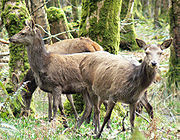
As Ireland was isolated from mainland Europe by rising sea levels after the ice age, it has less diverse animal and plant species than either Great Britain or mainland Europe. There are 55 mammal species in Ireland and of them only 26 land mammal species are native to Ireland. Some species, such as the red fox, hedgehog and badger, are very common, whereas others, like the Irish hare, red deer and pine marten are less so. Aquatic wildlife, such as species of turtle, shark, whale, and dolphin, are common off the coast. About 400 species of birds have been recorded in Ireland. Many of these are migratory, including the Barn Swallow. Most of Ireland's bird species come from Iceland, Greenland and Africa.
Several different habitat types are found in Ireland, including farmland, open woodland, temperate broadleaf and mixed forests, conifer plantations, peat bogs and a variety of coastal habitats. However, agriculture drives current land use patterns in Ireland, limiting natural habitat preserves, particularly for larger wild mammals with greater territorial needs. With no top predator in Ireland, populations of animals, such as semi-wild deer, that cannot be controlled by smaller predators, such as the fox, are controlled by annual culling.
There are no snakes in Ireland and only one reptile (the common lizard) is native to the island. Extinct species include the great Irish elk, the Irish wolf and the great auk. Some previously extinct birds, such as the Golden Eagle, have recently been reintroduced after decades of extirpation.
Until medieval times, Ireland was heavily forested with oak, pine and birch. Forests today cover only about 9% (4,450 km² or one million acres) of Ireland, which makes it the most deforested area in Europe. Much of the land is now covered with pasture, and there are many species of wild-flower. Gorse ( Ulex europaeus), a wild furze, is commonly found growing in the uplands and ferns are plentiful in the more moist regions, especially in the western parts. It is home to hundreds of plant species, some of them unique to the island, and has been "invaded" by some grasses, such as Spartina anglica.
The algal and seaweed flora is that of the cold-temperate variety. The total number of species is 574 and can be divided as follows:
- 264 Rhodophyta
- 152 Heterokontophyta
- 114 Chloropyta
- 31 Cyanophyta
Rarer species include:
- Itonoa marginifera (J.Ag.) (Masuda & Guiry)
- Schmitzia hiscockiana Maggs and Guiry
- Gelidiella calcicola Maggs & Guiry
- Gelidium maggsiae Rico & Guiry
- Halymenia latifolia P.Crouan & H.Crouan ex Kützing.
The island has been invaded by some algae, some of which are now well established. For example:
- Asparagopsis armara Harvey, which originated in Australia and was first recorded by M. De Valera in 1939
- Colpomenia peregrina Sauvageau, which is now locally abundant and first recorded in the 1930s
- Sargassum muticum (Yendo) Fensholt, now well established in a number of localities on the south, west, and north-east coasts
- Codium fragile ssp. fragile (formerly reported as ssp. tomentosum), now well established.
Codium fragile ssp. atlanticum has recently been established to be native, although for many years it was regarded as an alien species.
Because of its mild climate, many species, including sub-tropical species such as palm trees, are grown in Ireland. Phytogeographically, Ireland belongs to the Atlantic European province of the Circumboreal Region within the Boreal Kingdom. The island itself can be subdivided into two ecoregions: the Celtic broadleaf forests and North Atlantic moist mixed forests.
Impact of agriculture
The long history of agricultural production, coupled with modern intensive agricultural methods such as pesticide and fertiliser use and "Runoff" from contaminants into streams, rivers and lakes, impact the natural fresh-water ecosystems and have placed pressure on biodiversity in Ireland.
A land of green fields for crop cultivation and cattle rearing limits the space available for the establishment of native wild species. Hedgerows however, traditionally used for maintaining and demarcating land boundaries, act as a refuge for native wild flora. This ecosystem stretches across the countryside and act as a network of connections to preserve remnants of the ecosystem that once covered the island. Subsidies under the Common Agricultural Policy, which supported agricultural practices that preserved hedgerow environments, are undergoing reforms. The Common Agricultural Policy had in the past subsidised potentially destructive agricultural practices, for example by emphasising production without placing limits on indiscriminate use of fertilisers and pesticides, but recent reforms have gradually decoupled subsidies from production levels and introduced environmental and other requirements.
Forest covers about 10% of the country, with most designated for commercial production. Forested areas typically consist of monoculture plantations of non-native species, which may result in habitats that are not suitable for supporting native species of invertebrates. Remnants of native forest can be found scattered around the island, in particular in the Killarney National Park. Natural areas require fencing to prevent over-grazing by deer and sheep that roam over uncultivated areas. Grazing in this manner is one of the main factors preventing the natural regeneration of forests across many regions of the country.
Economy
Ireland was largely passed over by the industrial revolution. One reason given why Ireland did not experience an industrial revolution is because of the scarcity of coal and iron, resources that facilitate an industrial revolution. However, there were other countries that lacked these resources, but nonetheless industrialised, so there may be other reasons why Ireland did not industrialise. Nineteenth century explanations for why Ireland did not industrialise did not blame the absence of natural resources but that, "The fault is not in the country, but in ourselves; the absence of successful enterprise is owing to the fact, that we do not know how to succeed ... we want special industrial knowledge." Some historians today point to the sudden union with the structurally superior economy of England. They point out that iron and coal prices in Ireland were as cheap as they were in parts of England outside of the mining centres – and a little cheaper in some parts – and that, on the eve of union with Great Britain, Ireland was industrialising (particularly the linen industry). It may be that, by merging the two economies suddenly, Ireland did not industrialise, but "instead became a supplier of food – and capital – to the 'mainland'."
Mass emigration followed in the wake of the Great Famine in the mid-19th century and continued until the 1980s. However, the Irish economic experience reversed dramatically during the course of the 1990s, which saw the beginning of unprecedented economic growth in the Republic of Ireland, in a phenomenon known as the " Celtic Tiger", and peace being restored in Northern Ireland. In 2005, the Republic of Ireland was ranked the best place to live in the world, according to a " quality of life" assessment by The Economist magazine. The Republic of Ireland joined the euro in 1999, while Northern Ireland remained with the pound sterling. Both the Republic of Ireland and Northern Ireland entered recession in 2008 and, in 2009, the unemployment rate for the Republic of Ireland was 12.5% due to the 2008–2010 Irish financial crisis.
Transport
Ireland has five main international airports: Dublin Airport, Belfast International Airport (Aldergrove), Cork Airport, Shannon Airport and Ireland West Airport (Knock). Dublin Airport is the busiest of these, carrying over 22 million passengers per year and a new terminal and runway are under construction. All provide services to Britain and continental Europe, while Belfast International, Dublin and Shannon also offer transatlantic services. For several decades, Shannon was an important refuelling point for transatlantic routes. In recent years it has opened a pre-screening service allowing passengers to pass through US immigration services before departing from Ireland. There are also several smaller regional airports: George Best Belfast City Airport, City of Derry Airport, Galway Airport, Kerry Airport (Farranfore), Sligo Airport (Strandhill), Waterford Airport and Donegal Airport (Carrickfinn). Scheduled services from these regional points are in the main limited to flights traveling to other parts of Ireland and to Britain. Airlines based in Ireland include Aer Lingus (the former national airline of the Republic of Ireland), Ryanair, Aer Arann and CityJet.
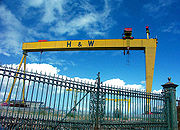
Ireland has ports in major ports in Dublin, Belfast, Cork, Rosslare, Derry and Waterford. Smaller ports exist in Arklow, Ballina, Drogheda, Dundalk, Dún Laoghaire, Foynes, Galway, Larne, Limerick, New Ross, Sligo, Warrenpoint and Wicklow. Ports in the Republic handle 3.6 million travellers crossing the sea between Ireland and Britain each year. The vast majority of heavy goods trade is done by sea. Ports in Northern Ireland handle 10 megatons (11 million short tons) of goods trade with Britain annually, while ports in the Republic of Ireland handle 7.6 Mt (8.4 million short tons).
Ferry connections between Ireland and Great Britain via the Irish Sea include routes from Dublin to Holyhead, Birkenhead, and Douglas, Isle of Man, Belfast to Stranraer, Birkenhead and Douglas, Isle of Man, Larne to Cairnryan and Troon, Cork to Swansea and Rosslare to Fishguard and Pembroke.
There are also ferry connections to France, from Rosslare to Roscoff and Cherbourg, and also from Cork to Roscoff.
Several (mainly hypothetical) plans to build an " Irish Sea tunnel" have been proposed. The first serious proposal was made in 1897, which was for a tunnel between Ireland and Scotland crossing the North Channel. Most recently, in 2004, the Institution of Engineers of Ireland proposed the " Tusker Tunnel" between the ports of Rosslare and Fishguard. In 1997 a British engineering firm, Symonds, proposed a rail tunnel from Dublin to Holyhead. Either of the two most recent proposals, at 80 km (50 mi), would be by far the longest tunnel in the world and would cost an estimated €20bn.
The railway network in Ireland was developed by various private companies during the 19th century, with some receiving government funding in the late 19th century. The network reached its greatest extent by 1920. A broad gauge of 1,600mm (5 ft 3in) was agreed as the standard the island, although there were also hundreds of kilometres of 914mm (3 ft) narrow gauge railways.
Long distance passenger trains in the Republic of Ireland are managed by Iarnród Éireann and connect most major towns and cities. In Northern Ireland, all rail services are provided by Northern Ireland Railways. Additionally, Ireland has one of the largest dedicated freight railways in Europe, operated by Bord na Móna totalling nearly 1,400 kilometres (870 mi).
In Dublin, two local rail networks provide transport in the city and its immediate vicinity. The Dublin Area Rapid Transit (DART) links the city centre with coastal suburbs. A new light rail system, the Luas, opened in 2004 and transports passengers to the central and western suburbs. Several more Luas lines are planned as well as an Dublin Metro. The DART is run by Iarnród Éireann and the Luas is run by Veolia under franchise from the Railway Procurement Agency. Under the Irish government's Transport 21 plan, the Cork to Midleton rail link was reopened in 2009. The re-opening of the Navan- Clonsilla rail link and the Western Rail Corridor are amongst future projects as part of the same plan.
Services in Northern Ireland are sparse in comparison to the rest of Ireland or Britain. A large railway network was severely curtailed in the 1950s and 1960s. Current services includes suburban routes to Larne, Newry and Bangor, as well as services to Derry. There is also a branch from Coleraine to Portrush.
Motorists in Ireland drive on the left. There is an extensive road network and a developing motorway network fanning out from Dublin and Belfast in particular. Historically, land owners developed most roads and later Turnpike Trusts collected tolls so that as early as 1800 Ireland had a 16,100 kilometres (10,000 mi) road network. In recent years, the Irish Government launched a new transport plan that is the largest investment project ever in Ireland's transport system: investing €34 billion from 2006 until 2015. Work on a number of road projects has already commenced and a number of objectives have been completed.
Ireland's first mail coach services were contracted with the government by John Anderson with William Bourne in 1791 who also paid to improve the condition of the roads. The system of mail coaches, carriages and "bians" was further developed by Charles Bianconi, based in Clonmel, from 1815 as a fore-runner of the modern Irish public transportation system. Today, the main bus companies are Bus Éireann in the Republic and Ulsterbus in Northern Ireland, both of which offer extensive passenger service in all parts of the island. Dublin Bus specifically serves the greater Dublin area and Metro operates services within the greater Belfast area.
Signposts and speed limits in the Republic of Ireland are shown in kilometres per hour, with speed limits having changed in 2005. Distance and speed limit signs in Northern Ireland use imperial units in common with the rest of United Kingdom.
Electricity networks
For much of their existence electricity networks in the Republic of Ireland and Northern Ireland were entirely separate. Both networks were designed and constructed independently post partition. However, as a result of changes over recent years they are now connected with three interlinks and also connected through Great Britain to mainland Europe. The situation in Northern Ireland is complicated by the issue of private companies not supplying Northern Ireland Electricity (NIE) with enough power. In the Republic of Ireland, the ESB has failed to modernise its power stations and the availability of power plants has recently averaged only 66%, one of the worst such rates in Western Europe. EirGrid is building a HVDC transmission line between Ireland and Britain with a capacity of 500 MW, about 10% of Ireland's peak demand.
Similar to electricity, the natural gas distribution network is also now all-island, with a pipeline linking Gormanston, County Meath, and Ballyclare, County Antrim. Most of Ireland's gas comes through interconnectors between Twynholm in Scotland and Ballylumford, County Antrim and Loughshinny, County Dublin. A decreasing supply is coming from the Kinsale gas field off the County Cork coast and the Corrib Gas Field off the coast of County Mayo has yet to come on-line. The County Mayo field is facing some localised opposition over a controversial decision to refine the gas onshore.
There have been recent efforts in Ireland to use renewable energy such as wind power. Large wind farms are being constructed in coastal counties such as Cork, Donegal, Mayo and Antrim. What will be the world's largest offshore wind farm is currently being developed at the Arklow Bank Wind Park off the coast of County Wicklow. It is predicted that the Arklow wind farm will generate 10% of Ireland's power needs when it is complete. The construction of wind farms has in some cases been delayed by opposition from local communities, some of whom consider the wind turbines to be unsightly. The Republic of Ireland is also hindered by an ageing network that was not designed to handle the varying availability of power that comes from wind farms. The ESB's Turlough Hill facility is the only power-storage facility in the state.
Demographics
People have lived in Ireland for over 9,000 years, although little is known about the palaeolithic and neolithic inhabitants of the island. Early historical and genealogical records note the existence of dozens of different peoples that may or may not be mythological, for example the Cruithne, Attacotti, Conmaicne, Eóganachta, Érainn, and Soghain, to name but a few. Over the past 1000 years or so, Vikings, Normans, Scots and English have all added to the Gaelic population.
Ireland's largest religious group is Christianity. The largest denomination is Roman Catholicism representing over 73% for the island (and about 87% of the Republic of Ireland). Most of the rest of the population adhere to one of the various Protestant denominations (about 53% of Northern Ireland). The largest is the Anglican Church of Ireland. The Muslim community is growing in Ireland, mostly through increased immigration. The island has a small Jewish community. About 4% of the Republic's population and about 14% of the Northern Ireland population describe themselves as of no religion. In a 2010 survey conducted on behalf of the Irish Times, 32% of respondents said they went to a religious service more than once a week.
The population of Ireland rose rapidly since the 16th century until the mid-19th century, but a devastating famine in the 1840s caused one million deaths and forced over one million more to emigrate in its immediate wake. Over the following century, the population reduced by over half, at a time when the general trend in European countries was for populations to rise by an average of three-fold.
Emigration from Ireland over this period contributed to the populations of England, the United States, Canada and Australia where today a large Irish diaspora live. Today 4.3 million Canadians, or 14% of her population, are of Irish descent. A total of 36 million Americans claim Irish ancestry – more than 12% of the total population and 20% of the white population. Massachusetts is the most Irish of US states with 23.8% of the population claiming Irish ancestry. The pattern of immigration over this period particularly devastated the western and southern sea-boards. Prior to the Great Famine, the provinces of Connacht, Munster and Leinster were more or less evenly populated whereas Ulster was far less densely populated than the other three. Today, Ulster and Leinster, and in particular Dublin, have a far greater population density than Munster and Connacht.
With growing prosperity since the last decade of the 20th century, Ireland became a place of immigration until the financial crisis that began in 2008. Since joining the European Union expanded to included Poland in 2004, Polish people have made up the largest number immigrants (over 150,000) from Central Europe, followed by other immigrants from Lithuania, the Czech Republic and Latvia. The Republic of Ireland in particular has seen large-scale immigration. The 2006 census recorded that 420,000 foreign nationals, or about 10% of the population, lived in the Republic of Ireland. Chinese and Nigerians, along with people from other African countries, have accounted for a large proportion of the non–European Union migrants to Ireland. Up to 50,000 eastern European migrant workers may have left Ireland towards the end of since 2008.
English has been spoken in Ireland since the Middle Ages and, since a language shift during the 19th century, has replaced Irish as the first language for a vast majority of the population. Less than 10% of the population of the Republic of Ireland today speak Irish regularly outside of the education system and 38% of those over 15 years are classified as "Irish speakers". In Northern Ireland, English is the de facto official language but official recognition is afforded to both Irish and Ulster Scots, which is also spoken by a number of people south of the border. In recent decades, with the increase in immigration, many more languages have been introduced, particularly deriving from Asia and Eastern Europe.
Culture
Ireland's culture comprises elements of the culture of ancient immigration and influences (such as Gaelic culture) and more recent Anglicisation and Americanisation as well as participation in a broader European culture. In broad terms, Ireland is regarded as one of the Celtic nations of Europe, which also includes Scotland, Wales, Cornwall, Isle of Mann and Brittany. This combination of cultural influences is visible in the intricate designs termed Irish interlace or Celtic knotwork. These can be seen in the ornamentation of medieval religious and secular works. The style is still is popular today in jewellery and graphic art, as is the distinctive style of traditional Irish music and dance, and has become indicative of modern "Celtic" culture in general.
Religion has played a significant role in the cultural life of the island since ancient times (and since the 17th century plantations, has been the focus of political identity and divisions on the island). Ireland's pre-Christian heritage fused with the Celtic Church following the missions of Saint Patrick in the 5th century. The Hiberno-Scottish missions, begun by the Irish monk Saint Columba, spread the Irish vision of Christianity to pagan England and the Frankish Empire. These missions brought written language to an illiterate population of Europe during the Dark Ages that followed the fall of Rome, earning Ireland the sobriquet, "the island of saints and scholars". In more recent years, the Irish pubs have become outposts of Irish culture worldwide.
The national theatre is the Abbey Theatre founded in 1904 and the national Irish-language theatre is An Taibhdhearc, established in 1928 in Galway. Playwrights such as Seán O'Casey, Brian Friel, Sebastian Barry, Conor McPherson and Billy Roche are internationally renowned.
Art
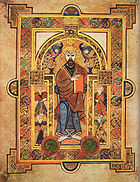
There are a number of languages used in Ireland. Irish is the main language to have originated from within the island. Since the later 19th century, English has become the predominant first language having been a spoken language in Ireland since the Middle Ages. A large minority claim some ability to speak Irish today, although it is the first language only of a small percentage of the population. Under the constitution of the Republic of Ireland, both languages have official status with Irish being the national and first official language. In Northern Ireland, English is the dominant state language, whilst Irish and Ulster Scots are recognised minority languages.
Ireland has made a large contribution to world literature in all its branches, particularly in the English language. Poetry in Irish is the oldest vernacular poetry in Europe, with the earliest examples dating from the 6th century. In English, Jonathan Swift, still often called the foremost satirist in the English language, was wildly popular in his day for works such as Gulliver's Travels and A Modest Proposal and Oscar Wilde is known most for his often quoted witticisms.
In the 20th century, Ireland produced four winners of the Nobel Prize for Literature: George Bernard Shaw, William Butler Yeats, Samuel Beckett and Seamus Heaney. Although not a Nobel Prize winner, James Joyce is widely considered to be one of the most significant writers of the 20th century. Joyce's 1922 novel Ulysses is considered one of the most important works of Modernist literature and his life is celebrated annually on 16 June in Dublin as " Bloomsday". Modern Irish literature is often connected with its rural heritage through writers such as John McGahern and poets such as Seamus Heaney.
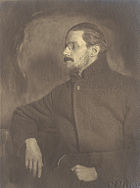
The Irish traditional music and dance has seen a recent surge in popularity, not least through the phenomenon of Riverdance, a theatrical performance of Irish traditional dancing. In the middle years of the 20th century, as Irish society was modernising, traditional music fell out of favour, especially in urban areas. During the 1960s, inspired by the American folk music movement, there was a revival of interest in Irish traditional music led by groups such as The Dubliners, The Chieftains, Emmet Spiceland, The Wolfe Tones, the Clancy Brothers, Sweeney's Men and individuals like Seán Ó Riada and Christy Moore.
Groups and musicians including Horslips, Van Morrison and Thin Lizzy incorporated elements of traditional music into contemporary rock music and, during the 1970s and 1980s, the distinction between traditional and rock musicians became blurred, with many individuals regularly crossing over between these styles of playing. This trend can be seen more recently in the work of artists like Enya, The Saw Doctors, The Corrs, Sinéad O'Connor, Clannad, The Cranberries, Black 47 and The Pogues among others.
During the 1990s, a sub-genre of folk metal emerged in Ireland that fused heavy metal music with Irish and Celtic music. The pioneers of this sub-genre were Cruachan, Primordial, and Waylander. Some contemporary music groups stick closer to a "traditional" sound, including Altan, Téada, Danú, Dervish, Lúnasa, and Solas. Others incorporate multiple cultures in a fusion of styles, such as Afro Celt Sound System and Kíla. The theme is can also be seen among Ireland's entries to the Eurovision Song Contest, where Ireland is also the most successful country in the competition with seven wins.
The earliest known Irish graphic art and sculpture are Neolithic carvings found at sites such as Newgrange and is traced through Bronze age artefacts and the religious carvings and illuminated manuscripts of the medieval period. During the course of the 19th and 20th centuries, a strong tradition of painting emerged, including such figures as John Butler Yeats, William Orpen, Jack Yeats and Louis le Brocquy.
Science
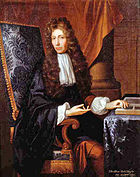
The Irish philosopher and theologian Johannes Scotus Eriugena was considered one of the leading intellectuals of his early Middle Ages. Sir Ernest Henry Shackleton, an Anglo-Irish explorer, was one of the principal figures of Antarctic exploration. He, along with his expedition, made the first ascent of Mount Erebus and the discovery of the approximate location of the South Magnetic Pole. Robert Boyle was an 17th century natural philosopher, chemist, physicist, inventor and early gentleman scientist. He is largely regarded one of the founders of modern chemistry and is best known for the formulation of Boyle's law. 19th century physicist, John Tyndall, discovered the Tyndall effect, which explains why the sky is blue. Father Nicholas Joseph Callan, Professor of Natural Philosophy in Maynooth College, is best known for his invention of the induction coil, transformer and he discovered an early method of galvanisation in the 19th century.
Other notable Irish physicists include Ernest Walton, winner of the 1951 Nobel Prize in Physics. With Sir John Douglas Cockcroft, he was the first to split the nucleus of the atom by artificial means and made contributions to the development of a new theory of wave equation. William Thomson, or Lord Kelvin, is the person whom the absolute temperature unit, the Kelvin, is named after. Sir Joseph Larmor, a physicist and mathematician, made innovations in the understanding of electricity, dynamics, thermodynamics and the electron theory of matter. His most influential work was Aether and Matter, a book on theoretical physics published in 1900.
George Johnstone Stoney introduced the term electron in 1891. John Stewart Bell was the originator of Bell's Theorem and a paper concerning the discovery of the Bell-Jackiw-Adler anomaly and was nominated for a Nobel prize. Notable mathematicians include Sir William Rowan Hamilton, famous for the invention of quaternions. Francis Ysidro Edgeworth was influential in the development of neo-classical economics, including the Edgeworth box. John B. Cosgrave was a specialist in number theory and discovered a 2000-digit prime number in 1999 and a record composite Fermat number in 2003. John Lighton Synge made progress in different fields of science, including mechanics and geometrical methods in general relativity. He had mathematician John Nash as one of his students.
Ireland has eight universities and numerous Institutes of Technologies as well as The Dublin Institute for Advanced Studies, which was established in 1940 with physicist Erwin Schrödinger as director.
Sport
Gaelic football is the most popular sport in Ireland in terms of match attendance and community involvement, and represents 34% of total sports attendances at events in Ireland and abroad, followed by hurling at 23%, soccer at 16% and rugby at 8%. and the All-Ireland Football Final is the most watched event in Ireland's sporting calendar. Swimming, golf, aerobics, soccer, cycling, Gaelic football and billiards/snooker are the sporting activities with the highest levels of playing participation. Soccer is the most popular sport involving national teams. Northern Ireland have also produced two World Snooker Champions, and is governed by NIBSA—Northern Ireland Snooker Association—as recognised by Sport NI.
Many other sports are also played and followed, including basketball, boxing, cricket, fishing, golf, greyhound racing, handball, hockey, horse racing, motor sport, rugby league, show jumping and tennis.
Field sports
Hurling and Gaelic football, handball and rounders make up the national sports of Ireland, collectively known as Gaelic games. Gaelic games are governed by the Gaelic Athletic Association (GAA), with the exception of ladies' Gaelic football and camogie (women's variant of hurling), which are governed by separate organisations. The headquarters of the GAA (and the main stadium) is located at the 82,500 capacity Croke Park in north Dublin. Many major GAA games are played there, including the semi-finals and finals of the All-Ireland Senior Football Championship and All-Ireland Senior Hurling Championship. During the redevelopment of the Lansdowne Road stadium in 2007–10, international rugby and soccer were played there. All GAA players, even at the highest level, are amateurs, receiving no wages, although they are permitted to receive a limited amount of sport-related income from commercial sponsorship.
The Irish Football Association (IFA) was originally the governing body for soccer across the island. The game has been played in an organised fashion in Ireland since the 1870s, with Cliftonville F.C. in Belfast being Ireland's oldest club. It was most popular, especially in its first decades, around Belfast and in Ulster. However, some clubs based outside Belfast thought that the IFA largely favoured Ulster-based, Protestant clubs in such matters as selection for the national team. In 1921, following an incident in which, despite an earlier promise, the IFA moved an Irish Cup semi-final replay from Dublin to Belfast
Dublin-based clubs broke away to form the Football Association of the Irish Free State. Today the southern association is known as the Football Association of Ireland (FAI). Despite being initially blacklisted by the Home Nations' associations, the FAI was recognised by FIFA in 1923 and organised its first international fixture in 1926 (against Italy). However, both the IFA and FAI continued to select their teams from the whole of Ireland, with some players earning international caps for matches with both teams. Both also referred to their respective teams as Ireland.
In 1950, FIFA directed the associations only to select players from within their respective territories and, in 1953, directed that the FAI's team be known only as " Republic of Ireland" and that the IFA's team be known as " Northern Ireland" (with certain exceptions). Northern Ireland qualified for the World Cup finals in 1958 (reaching the quarter-finals), 1982 and 1986. The Republic qualified for the World Cup finals in 1990 (reaching the quarter-finals), 1994, 2002 and the European Championships in 1988. There is significant Irish interest in the English and, to a lesser extent, Scottish soccer leagues.
Unlike soccer, Ireland continues to field a single national rugby team and a single association, the Irish Rugby Football Union (IRFU), governs the sport across the island. The Irish rugby team have played in every Rugby World Cup, making the quarter-finals in four of them. Ireland also hosted games during the 1991 and the 1999 Rugby World Cups (including a quarter-final). There are four professional Irish teams; all four play in the Magners League and three compete for the Heineken Cup. Irish rugby has become increasingly competitive at both the international and provincial levels since the sport went professional in 1994. During that time, Ulster ( 1999), Munster ( 2006 and 2008) and Leinster ( 2009) have won the Heineken Cup. In addition to this, the Irish International side has had increased success in the Six Nations Championship against the other European elite sides. This success, including Triple Crowns in 2006 and 2007, culminated with a clean sweep of victories, known as a Grand Slam, in 2009.
The Ireland cricket team was among the associate nations that qualified for the 2007 Cricket World Cup. It defeated Pakistan and finished second in its pool, earning a place in the Super 8 stage of the competition. The team also competed in the 2009 ICC World Twenty20 after jointly winning the qualifiers, where they also made the Super 8 stage. Ireland also won the 2009 ICC World Cup Qualifier to secure their place in the 2011 Cricket World Cup, as well as official ODI status through 2013.
The Irish rugby league team is made up predominantly of players based in England with Irish-family connections, with others drawn from the local competition and Australia. Ireland reached the quarter-finals of the 2000 Rugby League World Cup.
Other sports
Greyhound racing and horse racing are both popular in Ireland. Greyhound stadiums are well-attended and there are frequent horse race meetings. The island is noted for the breeding and training of race horses and is also a large exporter of racing dogs. The horse racing sector is largely concentrated in the County Kildare.
Irish athletics has seen some development in recent times, with Sonia O'Sullivan winning two notable medals at 5,000 metres; gold at the 1995 World Championships and silver at the 2000 Sydney Olympics. Gillian O'Sullivan won silver in the 20k walk at the 2003 World Championships, while sprint hurdler Derval O'Rourke won gold at the 2006 World Indoor Championship in Moscow. Olive Loughnane won a silver medal in the 20k walk in the World Athletics Championships in Berlin in 2009.
Boxing is governed by the Irish Amateur Boxing Association. In 1992, Michael Carruth won a gold medal for boxing in the Barcelona Olympic Games and in 2008 Kenneth Egan won a silver medal for boxing in the Olympic Games in Beijing.
Golf is very popular and golf tourism is a major industry attracting more than 240,000 golfing visitors annually. The 2006 Ryder Cup was held at The K Club in County Kildare. Pádraig Harrington became the first Irishman since Fred Daly in 1947 to win the British Open at Carnoustie in July 2007. He successfully defended his title in July 2008 before going on to win the PGA Championship in August. Harrington became the first European to win the PGA Championship in 78 years and was the first winner from Ireland. In 2010, Graeme McDowell, from Northern Ireland, became the first golfer from either side of the Irish border to win the U.S. Open, and the first European to win that tournament since Englishman Tony Jacklin won in 1970.
The west coast of Ireland, Lahinch and Donegal Bay in particular, have popular surfing beaches, being fully exposed to the Atlantic Ocean. Donegal Bay is shaped like a funnel and catches west/south-west Atlantic winds, creating good surf, especially in winter. In recent years, Bundoran has hosted European championship surfing. Scuba diving is increasingly popular in Ireland with clear waters and large populations of sea life, particularly along the western seaboard. There are also many shipwrecks along the coast of Ireland, with some of the best wreck dives being in Malin Head and off the County Cork coast.
With thousands of lakes, over 14,000 kilometres (8,700 mi) of fish bearing rivers and over 3,700 kilometres (2,300 mi) of coastline, Ireland is a popular angling destination. The temperate Irish climate is suited to sport angling. While salmon and trout fishing remain popular with anglers, salmon fishing in particular received a boost in 2006 with the closing of the salmon driftnet fishery. Coarse fishing continues to increase its profile. Sea angling is developed with many beaches mapped and signposted, and the range of sea angling species is around 80.
Food and drink
Irish food and cuisine takes its influence from the crops grown and animals farmed in the island's temperate climate and from the social and political circumstances of Irish history. For example, whilst from the Middle Ages until the arrival of the potato in the 16th century the dominant feature of the Irish economy was the herding of cattle, the number of cattle a person owned was equated to their social standing. Thus herders would avoid slaughtering a milk-producing cow.
For this reason, pork and white meat were more common than beef and a thick fatty strips of salted bacon (or rashers) and the eating of salted butter (i.e. a dairy product rather than beef itself) have been a central feature of the Irish diet since the Middle Ages. The practice of bleeding cattle and mixing the blood with milk and butter (not unlike the practice of the Maasai) was common and black pudding, made from blood, grain (usually barley) and seasoning, remains a breakfast staple in Ireland. All of these influences can be seen today in the phenomenon of the " breakfast roll".
The introduction of the potato in the second half of the 16th century heavily influenced cuisine thereafter. Great poverty encouraged a subsistence approach to food and by the mid-19th century the vast majority of the population sufficed with a diet of potatoes and milk. A typical family, consisting a man, a woman and four children, would eat 18 stone (110 kg) of potatoes a week. Consequently, dishes that are considered as national dishes represent a fundamental unsophistication to cooking, such as the Irish stew, bacon and cabbage, boxty, a type of potato pancake, or colcannon, a dish of mashed potatoes and kale or cabbage.
Since the last quarter of the 20th century, with a re-emergence of wealth in Ireland, a "New Irish Cuisine" based on traditional ingredients incorporating international influences has emerged. This cuisine is based on fresh vegetables, fish (especially salmon, trout, oysters, mussels and other shellfish), as well as traditional soda breads and the wide range of hand-made cheeses that are now being produced across the country. The potato remains however a fundamental feature of this cuisine and the Irish remain the highest per capita consumers of potatoes in Europe. An example of this new cuisine is "Dublin Lawyer": lobster cooked in whiskey and cream. Traditional regional foods can be found throughout the country, for example coddle in Dublin or drisheen in Cork, both a type of sausage, or blaa, a doughy white bread particular to Waterford.
Ireland once dominated the world's market for whiskey, producing 90% of the world's whiskey at the start of the 20th century. However, as a consequence of bootleggers during the prohibition in the United States (who sold poor-quality whiskey bearing Irish-sounding names thus eroding the pre-prohibition popularity for Irish brands) and tariffs on Irish whiskey across British Empire during the Anglo-Irish Trade War of the 1930s, sales of Irish whiskey worldwide fell to a mere 2% by the mid-20th century. In 1953, an Irish government survey, found that 50 per cent of whiskey drinkers in the United States had never heard of Irish whiskey.
Irish whiskey, however, remained popular domestically and in recent decades has grown in popularity again internationally. Typically, Irish whiskey is not as smoky as a Scotch whisky, but not as sweet as American or Canadian whiskies. Whiskey forms the basis of traditional cream liqueurs, such as Baileys, and the " Irish coffee" (a cocktail of coffee and whiskey reputedly invented at Foynes flying-boat station) is probably the best-known Irish cocktail.
Stout, a kind of porter beer, particularly Guinness, is typically associated with Ireland, although originally being more closely associated with London. Porter remains very popular, although it has lost sales since the mid-20th century to lager. Cider, particularly Magners (marketed in the Republic of Ireland as Bulmers), is also a popular drink. Red lemonade, a soft-drink, is consumed on its own and as a mixer, particularly with whiskey.

